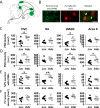Perineuronal nets in motor circuitry regulate the performance of learned vocalizations in songbirds
- PMID: 39827274
- PMCID: PMC11743155
- DOI: 10.1038/s42003-025-07520-2
Perineuronal nets in motor circuitry regulate the performance of learned vocalizations in songbirds
Abstract
The accurate and reliable performance of learned vocalizations (e.g., speech and birdsong) modulates the efficacy of communication in humans and songbirds. Consequently, it is critical to understand the factors that regulate the performance of learned vocalizations. Across taxa, neural circuits underlying motor learning and control are replete with perineuronal nets (PNNs), and we analyzed how PNNs in vocal motor circuitry regulate the performance of learned song in zebra finches. We report that developmental increases in PNN expression in vocal circuitry are associated with developmental increases in song stereotypy. We also document that enzymatically degrading PNNs in the motor nucleus HVC acutely altered song structure (changes in syllable sequencing and production). Collectively, our data reveal a causal contribution of PNNs to the performance of learned behaviors and, given the parallels in the regulation of birdsong and speech, suggest that PNNs in motor circuitry could modulate speech performance.
© 2025. The Author(s).
Conflict of interest statement
Competing interests: The authors declare no competing interests.
Figures




Similar articles
-
Songbirds can learn flexible contextual control over syllable sequencing.Elife. 2021 Jun 1;10:e61610. doi: 10.7554/eLife.61610. Elife. 2021. PMID: 34060473 Free PMC article.
-
Timing of perineuronal net development in the zebra finch song control system correlates with developmental song learning.Proc Biol Sci. 2018 Jul 18;285(1883):20180849. doi: 10.1098/rspb.2018.0849. Proc Biol Sci. 2018. PMID: 30051835 Free PMC article.
-
Independent premotor encoding of the sequence and structure of birdsong in avian cortex.J Neurosci. 2014 Dec 10;34(50):16821-34. doi: 10.1523/JNEUROSCI.1940-14.2014. J Neurosci. 2014. PMID: 25505334 Free PMC article.
-
At the interface of the auditory and vocal motor systems: NIf and its role in vocal processing, production and learning.J Physiol Paris. 2013 Jun;107(3):178-92. doi: 10.1016/j.jphysparis.2013.04.001. Epub 2013 Apr 17. J Physiol Paris. 2013. PMID: 23603062 Free PMC article. Review.
-
The neurobiology of innate and learned vocalizations in rodents and songbirds.Curr Opin Neurobiol. 2020 Oct;64:24-31. doi: 10.1016/j.conb.2020.01.004. Epub 2020 Feb 18. Curr Opin Neurobiol. 2020. PMID: 32086177 Free PMC article. Review.
References
-
- Doupe, A. J. & Kuhl, P. K. Birdsong and Human Speech: Common Themes and Mechanisms. Annu. Rev. Neurosci.22, 567–631 (1999). - PubMed
-
- Horwitz, B. et al. Activation of Broca’s area during the production of spoken and signed language: a combined cytoarchitectonic mapping and PET analysis. Neuropsychologia41, 1868–1876 (2003). - PubMed
-
- Moro-Velazquez, L., Gomez-Garcia, J. A., Arias-Londoño, J. D., Dehak, N. & Godino-Llorente, J. I. Advances in Parkinson’s Disease detection and assessment using voice and speech: A review of the articulatory and phonatory aspects. Biomed. Signal Process. Control66, 102418 (2021).
-
- Anderson, K. E. et al. Impact of psychogenic movement disorders versus Parkinson’s on disability, quality of life, and psychopathology. Mov. Disord.22, 2204–2209 (2007). - PubMed
MeSH terms
Grants and funding
LinkOut - more resources
Full Text Sources

